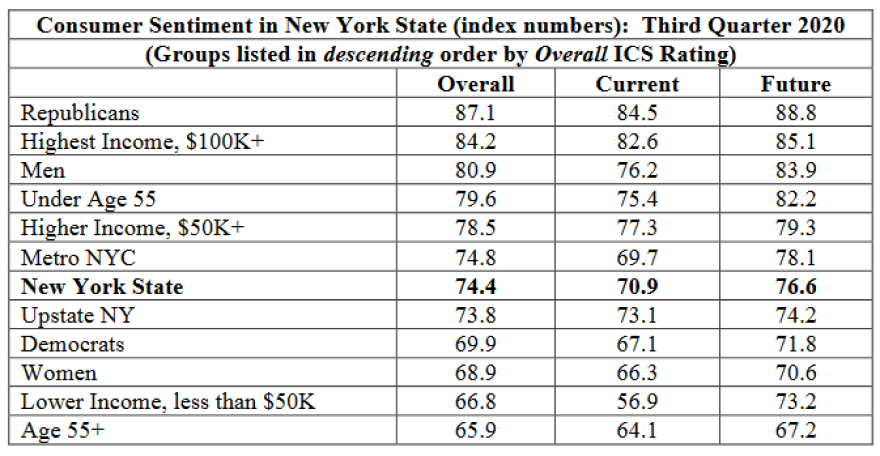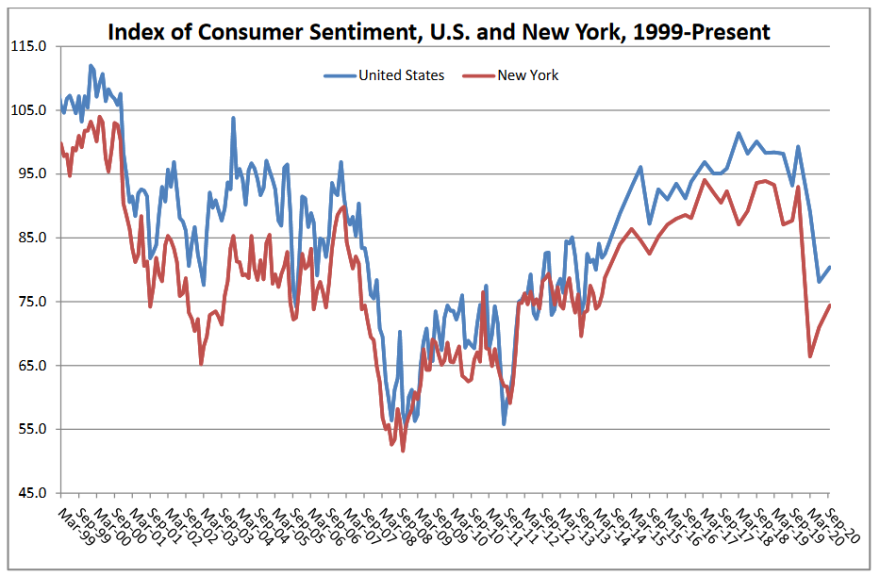Consumer sentiment among New Yorkers is on the rebound according to the latest Siena College poll.
Siena pollster Doug Lonnstrom says most of the numbers are up in the third quarter report:
"Except for a couple. Younger people and low-income people. Those are the only two numbers that are not positive. So in general, people are feeling a little bit better, not as good as pre-virus, but certainly a little bit better."
Lonnstrom says the survey reflects New Yorkers' optimism:
"We're generally behind the nation in confidence, but we've closed the gap a little. In future confidence we're actually ahead of the nation. Interesting, the Republicans top everything so far. They are the highest in overall confidence, in future confidence, and current confidence, so they're lookin' good. The figure that really jumped out at me was buying plans for homes. 13 percent of New Yorkers say they plan to buy a home in the next six months. That's a startling figure. That number often runs around 5, 6, 7 percent, so it's almost twice as high as normal. The interesting part is 17 percent of New York City people are planning to move out, OK, so New York City, it's been in the news that people aren't happy down there, and this is reflected that 17 percent of them are looking to buy a home and get out of New York City."

Lonnstrom says consumers expressed concern over gas prices.
"Last quarter, only 25 percent of people felt gas prices were hurting the family budget. That's now jumped up to 30 percent. And that's kind of startling to me, and I think the real reason is, if we go back to last spring when the virus hit, everybody stayed cooped up, nobody drove, so they didn't care about gas prices. Now all of a sudden they're getting out a little bit, you can go to a restaurant, you can go play golf. You're starting to drive more, so people are feeling the effect of gas prices. So, that was kind of a negative that gas prices themselves really didn't jump, it's just that now people are buying more gas, so rather than filling up once a month they're now filling up once a week, and they feel that."
The survey shows 59 percent of state residents indicate that the amount of money they spend on groceries is having either a very serious or somewhat serious impact on their finances.
Buying plans were slightly up from the second quarter of 2020 for cars and trucks, consumer electronics and furniture, but remain down about 10 percent from pre-coronavirus rates.
Lonnstrom says the numbers show New Yorkers are adjusting from the spring's COVID-19 "bottom-out" as they try to bring some normalcy back into their lives.
"What's happening is now, you're seeing some sports on TV, you able to go out to dinner, small groups, and so on. Outdoor dining is now gonna start disappearing with the weather. So people are able to get out a little bit more and I think making them feel a little bit better, but we could get another wave here, we're really concerned about that. I teach at Siena, we're monitoring our cases and we sometimes get one or two cases a day, but there's a danger when the cold weather comes, we might get a spike, and that's scary, so everybody is waiting for the other shoe to drop, and let's hope it never does."

The Siena College Poll can be viewed here [PDF]. It was conducted Aug 20-Sept 29, 2020 by random telephone calls to 402New York adults via landline and cell phones and 402 responses drawn from a proprietary online panel of New Yorkers.Respondent sampling via phone was initiated by asking for the youngest person in the household.
The overall results have an overall margin of error of +3.9 percentage points including the design effects resulting from weighting when applied to buying plans and/or the perceived impacts of gas and food prices.As consumer sentiment is expressed as an index number developed after statistical calculations to a series of questions, “margin of error” does not applyto those indices.
Telephone sampling was conducted via a stratified dual frame probability sample of landline (from ASDE Survey Sampler) and cell phone (from Dynata) telephone numbers from within New York State weighted to reflect known population patterns. Data from the telephone and web samples were blended and statistically adjusted by age, race/ethnicity, gender and party to ensure representativeness.






